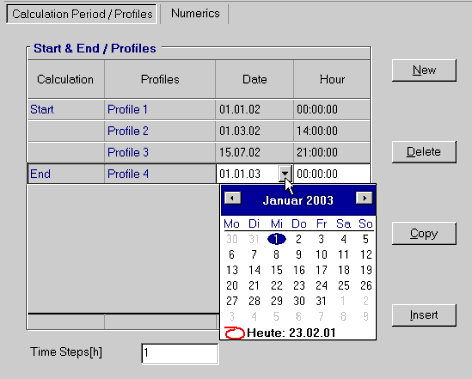1D:Dialog Time
Dialog: Calculation Period / Profiles
Here you tell WUFI for which period of time the simulation shall be carried out (e.g. the simulation is to span one year, starting on June 1st).
Enter the "Start" date and the "End" date in the
table, either directly or via the drop-down calendar.
WUFI calculates the courses for the time interval
between the starting and the ending date. For both dates,
profiles are also output.
You can get additional profiles for intermediate dates by inserting these dates in the
timetable (such as Profile 2 and Profile 3 in the above screenshot).
Most climate files represent typical climates and not individual years (e.g. "1995"). Therefore, any year number may be entered for the date.
If the calculation period extends beyond the end of the year, WUFI starts reading the same climate file again from the beginning. If the calculation period spans more than one year, WUFI reads the same climate file repeatedly.
You may also enter the size of the "Time Steps" used by WUFI during the calculation. Basically, there are no restrictions on the size of the time steps, but please note that the time step cannot be larger than the climate data interval.
If you are using hourly climate boundary conditions, a time step of one hour is an obvious choice and usually sufficient. For moisture transport calculations in building physics, time steps between ca. 10 minutes and ca. 24 hours may be adequate, depending on the problem at hand. With smaller time steps, computing time increases markedly, with larger time steps, the results may become inaccurate.
The simplest choice is to set the time step for the calculation equal to the time intervals in the climate file. If you want to use a different time step, you should choose it so that it divides the climate time intervals exactly. Otherwise, WUFI adjusts each time step so that it does divide the current climate interval exactly. This is further discussed in the help topic "The *.KLI Format for Climate Data".
A general discussion regarding the choice of an appropriate time step size can be found in the help topic "WUFI's performance and limitations".
Version notice: Start and end of calculation and time step are user-editable only in WUFI Pro. Additional profiles are available only in WUFI Pro. In WUFI light and WUFI ORNL/IBP the calculation is restricted to two years.
